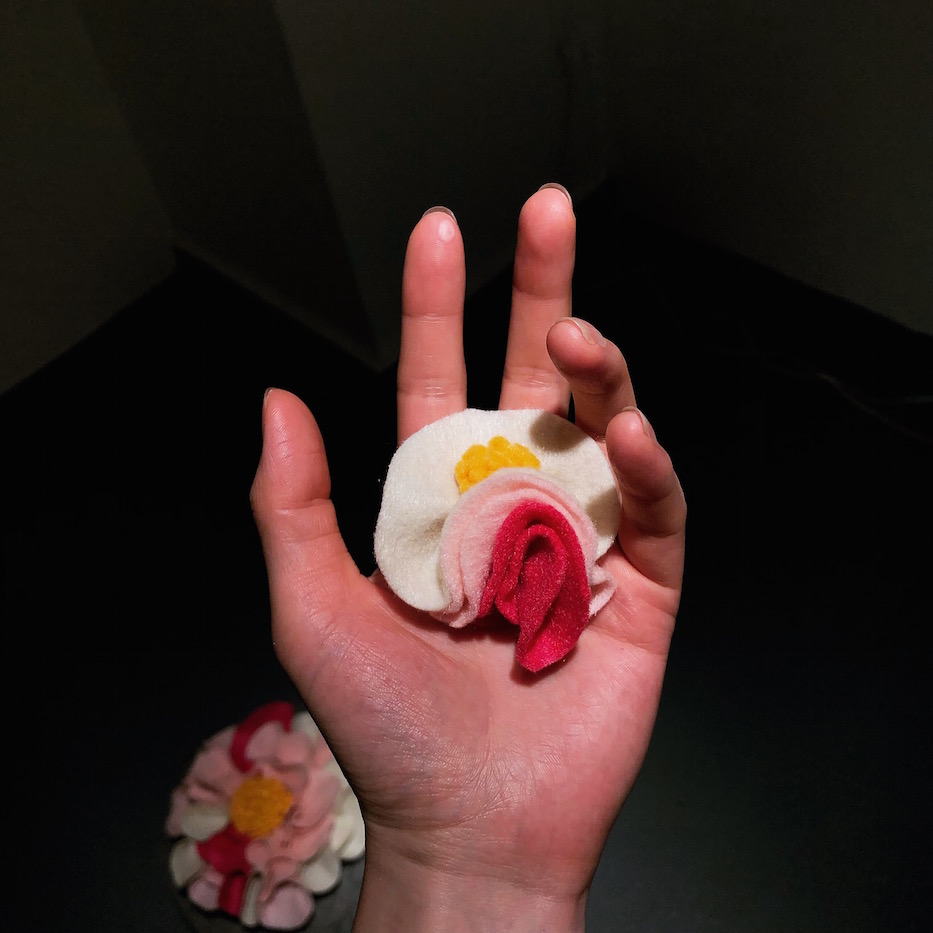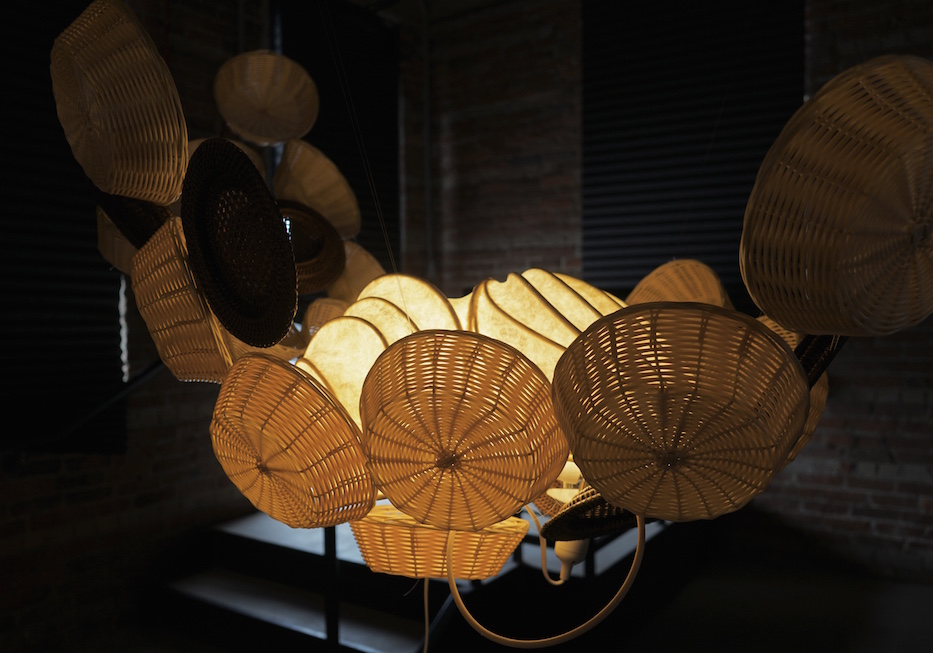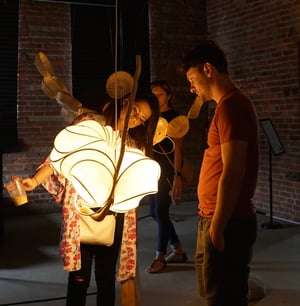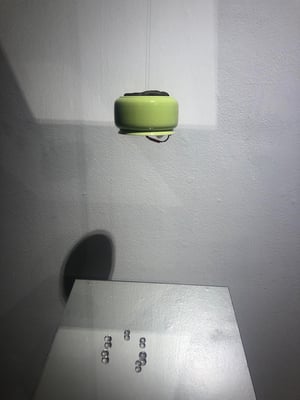
City-Wide Open Studios | Arts & Culture | Artspace New Haven | Visual Arts | Yale West Campus

| Photos contributed by the artist. |
Mengxi “Althea” Rao sits at her desk, which is streaked in orange and white paint. She’s wearing a white-striped dress, thinly-rimmed glasses, and light pink tennis shoes. When she speaks, she gestures with her hands, more urgently when she’s passionate about something.
Rao is an artist-in-residence at Artspace New Haven, tucked away on Orange Street in New Haven’s Ninth Square neighborhood. This weekend, she will present her ongoing project Vagina Chorus at Yale’s West Campus, as part of the final weekend of City-Wide Open Studios. She is one of 13 commissioned artists creating work around this year’s CWOS theme, “Older But Younger.”
The project uses Perifit’s Bluetooth Kegel training devices to “map raw vaginal pressure data onto musical notes,” meaning that one’s vagina strengthening exercises can literally make music. The artist said she started thinking of the project months ago, after learning that many women experience incontinence after pregnancy and childbirth, and with older age.
But her foray into art that meets public health and social justice draws on years of experience. Rao, who is now 27, grew up in China and came to the United States in 2014 for graduate school at Temple University. In 2017, she graduated knowing that she would have to file for a visa “for extraordinary ability,” which grants residency to artists, scholars, and athletes who can prove that they excel in their respective art and have reason to remain in the United States, within a year.
To counterbalance the constant production required of her immigration status, she developed (and still sticks to) a tight schedule, dividing her days into meetings, studio work, and fellowship applications.
“It’s from a feeling that I don’t have enough control in my own life,” she said in a recent interview at her studio. “I don’t have the freedom to decide I want to take a break, do a gap year … I have to do project after project. Even if a project isn’t finished, I have to start another.”

| Section, Pillar Of Salt. Photo courtesy of the artist. |
Before coming to New Haven, she was one of eight 2018 Social Impact Fellows at Halcyon Arts Lab in Washington D.C. While there, she set up public space activations at the Goethe Institut, Corcoran Gallery, Smithsonian Freer|Sackler Gallery, The French Embassy and Hirshhorn Museum. Her work on gender equity was featured during By the People Festival in 2019.
Much of the work gives her an opening to flex a social justice muscle not so different from that in Vagina Chorus. In Pillar of Salt: Illuminated History in Writing, which she created through the Halcyon Arts Lab residency, the artist invites the onlooker to be a participant in creating crowd-sourced written history. When the project was up in Washington, participants were invited to respond to the artist’s prompts through an “intention setting writing ritual” complete with pieces of paper.

To a series of questions—To advance gender equality, what are you doing well? What can/will you do better?—Rao collected commitments, and used the pieces on which they were written to construct light sculptures. In doing so, she explained, the project was literally and figuratively illuminating people’s personal relationships with existing gender stereotypes and their ideas for promoting gender equity.
Now, the piece hangs in her studio at Artspace, light radiating through a snowflake-like vessel. She honed her technique through an apprenticeship in Oregon last fall, where she worked with the 90-year-old artist Stephen White at his studio.
“I see [light sculpture] as being a way to engage people,” Rao said. Light has the quality of attracting attention, such that one can write an idea on paper, but “it’s different seeing the word being lit up.”
Activating Reflection
The attention of the viewer is a large part of Rao’s interactive artwork. As she worked in her studio on a recent weekday, Rao said she often thinks about questions of audience access, and chooses to present her work in spaces where people already are, so as not to ask them to displace themselves from their environments. Last year, she exhibited a light sculpture in the lobby of a Washington, D.C. public library, and another time in the waiting area of a yoga community center in Washington, D.C.
The importance of access became clear to Rao a few years ago in Philadelphia, where she was working as a public art ambassador on Cai Guo-Qiang’s public art commission Fireflies. Cai decorated 27 pedicabs with traditional Chinese lanterns, giving whimsical free rides to citizens. Although the work was intended to be walk-up friendly and allow for art experience in people’s daily lives, the actual experience went the opposite way.
Rao directed traffic on-site and was instructed to prioritize people who had made online reservations, which were completely booked within the first 24 hours. She recalled seeing people who did not have reservations—often tourists, local residents, passers-by, less well-dressed individuals and parents or grandparents with kids —standing on the street waiting in the huge walk-up line.
On an average day, the wait time was at least 45 minutes, turning away many citizens who had not anticipating making such a time investment to experience “this thing created for the public.” After this experience, Rao definitively decided she wanted to create art that responded to community needs first.
Rao’s emphasis on public interaction comes from her desire to help people bring private shame into the public realm, where they can move to a place of acceptance and healing. She said sees her creations like algorithms: each individual enters the space with their own input and circumstances, and what they get out of the experience depends on what they brought with them when they entered the space.
“I believe I’m in no better position than the people who view my work,” she said. “My only hope is to activate them, make them think, and they’ll come to their individual conclusion.”
Much of Rao’s work is physical, and emotions are communicated through touch, not speech (“You let [the emotions] flow through your body,” she said in a recent interview). Her project Blindfold, for instance, was born out of an allegation of sexual harassment and the silence that ensued.
The central image of the sculpture is a pair of female eyes projected onto the top one of a pile of cardboard boxes. Strips of fabric are wrapped around the box, symbolizing an attempt of blocking the “female gaze.” Around the box pile, dozens of four-by-six photographs hang from the ceiling. Half of them include a woman’s blindfolded eyes; the other half are blank with projection mapping of recycled images in popular culture of women’s eyes.
Rao was harassed by a professor in school, who allegedly justified his actions by saying that the artist had “manifested romantic interest” in him by repeated attempts to lock eyes with him in a suggestive manner. Even though he was forced into retirement, Rao said she fears that his perception of women, specifically women of color, and their “gaze,” never really changed. According to Rao, the professor abused his power against another student after this.
“The important thing [in my work] is to create an arch so a person can have the chance to better him, her or themselves, to create positive change,” she said. “I’m finding a way to encourage a person to go back to their background, their culture, upbringing, and bring that into the work that’s being presented in the space.”
Hearing Vagina Chorus
On a second visit to Rao's studio, there was a new book is sitting on her desk: The Bathroom Key: Put an End to Incontinence by Kathryn Kassai and Kim Perelli. At the time, Rao was reading it as part of her research for her current project, a musical and light installation piece called Vagina Chorus. As she spoke on the project, she pulled out three “vulvas”—pink and orange felt flowers—set to become part of the installation she is presenting at City-Wide Open Studios.
Vagina Chorus is an interactive project examining public health and incontinence, a lack of control over urination that is twice as likely to happen in people who have vaginas, and is intensified in processes such as pregnancy, childbirth, menopause and gender reassignment surgery. When the pelvic floor becomes weaker or damaged in these events, this can cause urinary incontinence or leakage.
In the U.S., an estimated 45 percent of people who have vaginas experience symptoms of urinary incontinence. The project aims to increase pelvic health literacy, aiming to lift the shame and negativity attached to pelvic health, sexual wellness and aging.
Rao pulled out a device—a green “elvie”—which has a Bluetooth and connects to the phone (one is pictured below). One can perform kegel exercises through this device by tightening the pelvic floor muscles. People tend to keep their incontinence problems secretive and delay treatment, Rao said, because the pain is “tolerable,” and because of stigma and shame, financial hardship, and other reasons.
In the project’s current iteration, Rao is recruiting 16 singers from consistently underserved communities—transgender folks, people experiencing incarceration, and others—and training them to perform a symphony of notes and choreographed light visualizations with their pelvic floor exercises. The project seeks to interweave the life stories of the singers with a process of physical healing.

As she deepens the project, Rao said she is particularly interested in working with is the transgender community in New Haven. She explained that people who have undergone vaginoplasty might lose lubrication and develop scar tissues, which can contribute to more painful intercourse. There is not significant medical research on the way that incontinence affects transgender people, Rao said, making it all the more important to start conversations about the intersections of these communities.
“These individuals own the narrative of their own community, and can gain tools to speak to their community,” she said.
Already, she has teamed up with a technical adviser and a composer to create the software platform and interactive choral music. She said she also plans on establishing partnerships with local organizations who are already serving marginalized populations.
“Growing up, I wasn’t encouraged to understand more about my body and how it functions,” she said. “A lot of what men believe about women’s bodies is wrong, women are not encouraged to see what their bodies actually are.”
She added that making knowledge available about women’s bodies is the first step “to change the structure of patriarchy.”
After its first performance at CWOS this weekend—which Rao is considering a preview—Vagina Chorus will have its official launch in in Fall 2020. Starting next spring, Rao plans to organize pop-up clinics and pelvic health workshops with medical professionals for the public to accompany the performance.
At the workshops, attendees will receive a one-page worksheet on incontinence and kegel exercises that outlines at-a-glance information about pelvic health, incontinence, and different options for medical treatments and insurance plans. Rao is not prescribing the kegel device, but presenting it as an option.
Rao said she hopes that the project can motivate people to learn about and care for their own bodies, despite oppressive narratives surrounding the female body and reproductive system worldwide. The project also aims to increase pelvic health literacy, in the process lessening the shame around sexual wellness, pelvic health and aging.
As it opens at Yale’s West Campus this weekend, Rao said she wanted to depict what it might feel like to walk into a vagina. She plans to cover the 11-by-9 wall with flowers—the vulva—so that the light sculpture floats on a soft structure. She is using pink, purple, brown and orange felt petals to depict ideas of softness and femininity—the fabric emulates the moisture and stretchiness of the vagina. She also plans to add texture, light, and scent.
“The creation of a piece of artwork isn’t the destination, helping people is the priority,” she said.
Some New Haveners have already caught a glimpse of her work. At the end of September, Rao’s studio looked like a space in the middle of production: cut-up pieces of felt and structures made of reed scattered over the desk and the floor. They were for a “puberty light sculpture” that Artspace showed in early October, during an opening celebration of City-Wide Open Studios. At the event, visitors walked through the room, bending over and examining the flowers held in a green cup-like structure with a mirror below, reflecting the flowers as they seemed to unfurl in the light.
After CWOS, Rao will be at Signal Cultural Media Lab in upstate New York as a toolmaker-in-residence for two weeks this November before coming back to Artspace to continue her residency until August of next year.
She’s already thinking about her next project—The Hands that Feed Us—which will use life-size drawing installations to represent the stories of the over 40,000 Latino kitchen workers laboring in Chinese restaurants.
“Latino workers do the most unwanted grueling labor behind the scenes [in these restaurants],” she said. “Their own identities, working conditions and ‘American dreams’ remain undocumented and overlooked.”
Through field research, community conversations, and site specific activations, the project will seek to increase representations and support of “Amigos” in Chinese restaurants, and to help the two immigrant communities find commonality and build empathy.
Mengxi “Althea” Rao's Vagina Chorus will be on view Nov. 2 and 3 at Yale West Campus as part of the final weekend of City-Wide Open Studios. Find out more here.

